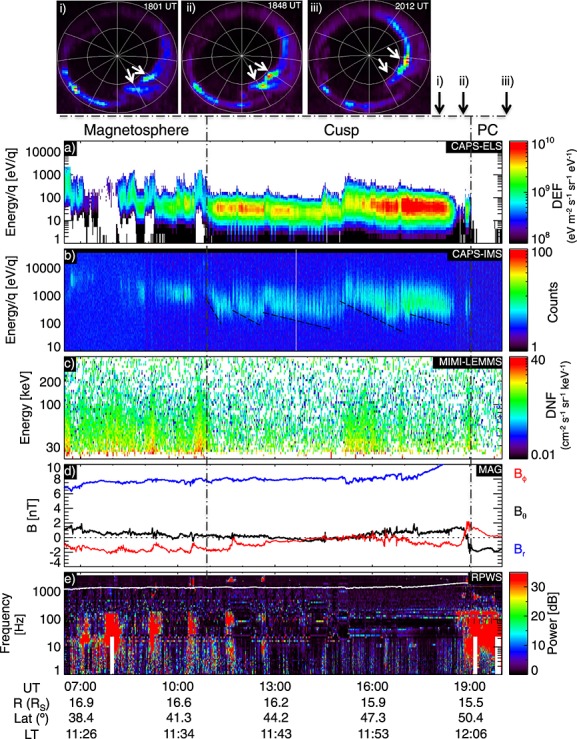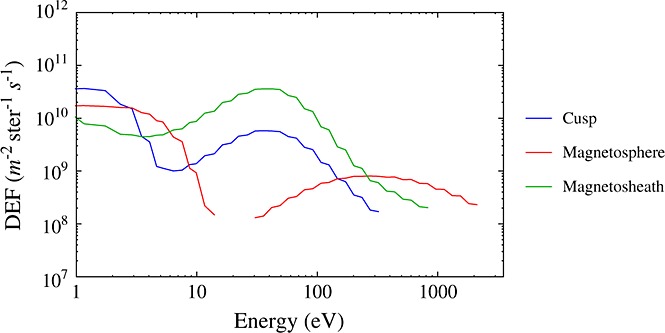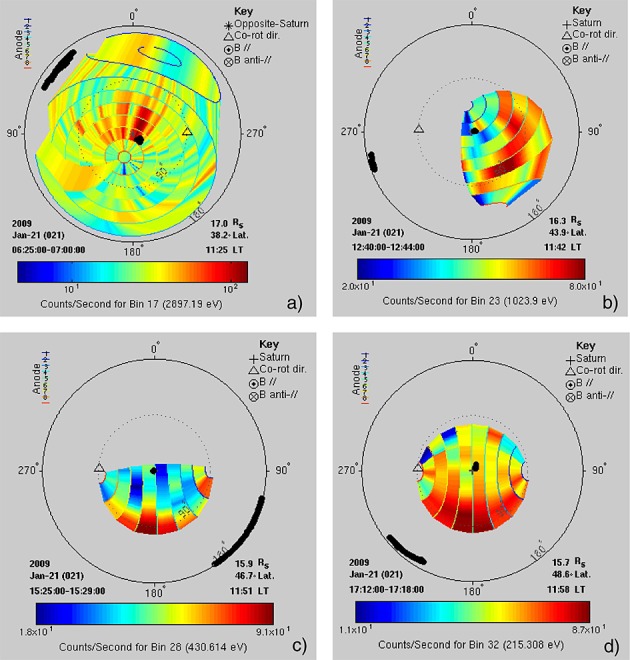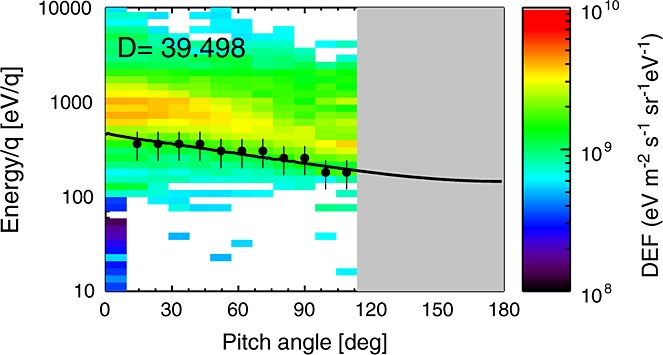Abstract
We report on the first analysis of magnetospheric cusp observations at Saturn by multiple in situ instruments onboard the Cassini spacecraft. Using this we infer the process of reconnection was occurring at Saturn's magnetopause. This agrees with remote observations that showed the associated auroral signatures of reconnection. Cassini crossed the northern cusp around noon local time along a poleward trajectory. The spacecraft observed ion energy-latitude dispersions—a characteristic signature of the terrestrial cusp. This ion dispersion is “stepped,” which shows that the reconnection is pulsed. The ion energy-pitch angle dispersions suggest that the field-aligned distance from the cusp to the reconnection site varies between ∼27 and 51 RS. An intensification of lower frequencies of the Saturn kilometric radiation emissions suggests the prior arrival of a solar wind shock front, compressing the magnetosphere and providing more favorable conditions for magnetopause reconnection.
Key Points
We observe evidence for reconnection in the cusp plasma at Saturn
We present evidence that the reconnection process can be pulsed at Saturn
Saturn's cusp shows similar characteristics to the terrestrial cusp
Keywords: cusp, reconnection, plasma, dispersion, Cassini
1. Introduction
The magnetospheric cusp is a permanent funnel-shaped region which is present in any magnetosphere [e.g., Russell, 2000]. Solar wind plasma can flow into the cusp via diffusive processes since the magnetic field strength is weak, or through the process of reconnection. Reconnection between interplanetary magnetic field (IMF) and closed magnetospheric field lines results in solar wind (SW) plasma flowing into the magnetosphere along the open field lines, through the cusp [Smith and Lockwood, 1996].
Reconnection at Saturn is a highly debated topic. McAndrews et al. [2008] presented magnetopause crossings which suggested the presence of reconnection signatures. Auroral evidence of consecutive reconnection events at Saturn's magnetopause were reported by Radioti et al. [2011]. Badman et al. [2013] reported in situ evidence for reconnection simultaneously with signatures of reconnection in auroral observations. On the other hand, Masters et al. [2012] showed that dayside reconnection may not be as common at Saturn as at Earth due to the typically high magnetosheath beta; moreover, the consequences of reconnection apparently differ, with no evidence of flux transfer events [Lai et al., 2012] or low-latitude boundary layer response to the IMF seen at Saturn [Masters et al., 2011]. Diffusive processes can also cause plasma entry into the magnetosphere. Studying the cusp is important as it can provide remote evidence for dayside reconnection and magnetically maps to a large area of the magnetopause, providing more information to the ongoing debate of the nature of reconnection at Saturn.
At Earth, the ionospheric cusp footprint is usually observed near 1200 local time (LT). Cowley et al. [2005] showed that due to Saturn's fast rotation, a newly open flux tube can have a significant azimuthal motion, and therefore, the cusp may be observed after 1200 LT. The first evidence of Saturn's auroral cusp footprint came from observations made by the Hubble Space Telescope [Gérard et al., 2005]. It was observed as a spot at 1200 LT and was inferred to be due to reconnection occurring in the lobes.
In this paper we report on in situ observations and analysis of the cusp for the first time. The associated characteristics of the cusp are Earth-like with similar dispersions observed. From the analysis the field-aligned distance from the cusp to the site of reconnection is shown to change. Details of instrumentation, observations, and methods are discussed in the supporting information.
2. Observations
2.1. Overview
The cusp was observed on the 21 January 2009 when Cassini was at ∼1135–1205 LT, at a radial distance of ∼15 RS from Saturn, a magnetic latitude of ∼45°, and an L shell of ∼31 RS.
In Figure 1 we present in situ and remote-sensing observations obtained during and just prior to the cusp crossing. From 0700 to 0800 UT Cassini was in Saturn's magnetosphere, traveling poleward. In Figure 1a, CAPS (Cassini Plasma Spectrometer) data show high-energy, tenuous electrons and in Figure 1b very low ion fluxes, observations which are typical of the high-latitude magnetosphere. In Figure 1c, LEMMS (Low-Energy Magnetospheric Measurement System) data show increases in flux of high-energy electrons when the spacecraft is in the magnetosphere.
Figure 1.

Observations from the 21 January 2009. In the top panel are three polar projections of Saturn's northern aurora, obtained with the FUV channel of Ultraviolet Imaging Spectrograph (UVIS), taken at 1801, 1848, and 2012 UT. The grid shows latitudes at intervals of 10° and meridians of 30°. Noon is to the bottom and dawn to the left. The times at which the images are taken in comparison to the in situ observations are indicated by black arrows (i–iii). Below the auroral observations: (a) omnidirectional electrons from the Electron Spectrometer (ELS)-CAPS, (b) ions from the Ion Mass Spectrometer (IMS)-CAPS presented in counts/accumulation, (c) high-energy electron data from LEMMS, (d) the three KRTP components of the magnetic field, and (e) Radio and Plasma Wave Science (RPWS) electric field spectrogram. The stepped ion structure is underlined in the CAP-IMS data. The polar cap is labeled as “PC.”
From just before 0900 until 1100 UT, CAPS observed intermittent magnetospheric high-energy tenuous plasma, and more dense cool plasma. At the same time, Figure 1d shows that MAG (Dual Technique Magnetometer) observed rotations in the Bφ component of the magnetic field, which are indicative of field-aligned currents (FACs) [e.g., Bunce et al., 2008]. It has been shown that FACs coincide with observations of whistler mode radio emission. During this event, the FACs derived from Bφ are found to be consistent with past observations, and whistler mode emission was observed (Figure 1e) by RPWS (Radio and Plasma Wave Science) instrument. When the ELS (Electron Spectrometer) observed colder electrons, IMS (ion mass spectrometer) observed significant increases in ion fluxes.
From 1100 to almost 1900 UT, Cassini observed the cusp, which is marked by the dashed vertical lines. ELS observed steadier fluxes of cold dense electrons, similar to magnetosheath plasma. At ∼1500 UT, Cassini observed a large change in the electron flux. The observed electrons had a slightly higher energy (an increase of ∼100 eV) and there was an increase in flux from 1600 UT for ∼2 h. From 1100 UT onward, IMS observed ions which had a “stepped” energy-time dispersion structure (underlined in Figure 1). This step structure in the ions and the changes in the electron parameters suggests that Cassini was traversing different reconnected magnetic flux tubes in the cusp attributed to “bursts” or “pulses” of reconnection occurring at different areas along the magnetopause [Lockwood and Smith, 1994; Lockwood et al., 2001].
At ∼1900 UT, Cassini entered the polar cap (PC), which are also open field lines, where electron and ion fluxes were at or below the noise level, and auroral hiss appears in the RPWS data (indicative of open field lines in the polar cap which are devoid of detectable plasma). Also presented are three images of the aurora taken after and at the end of the in situ observations presented. They show the existence of bifurcations of the main auroral emission (marked with white arrows).
Our identification of the region from ∼1100 to almost 1900 as cusp is supported by two strong pieces of evidence from CAPS observations: (1) As described in greater detail in the supporting information, composition measurements indicate that the ions are of solar wind origin (H+ and m/q=2 ions were in the ratio 25–100 [see supporting information for more details], with no appreciable W+,); and (2) the electron energy spectra are much more characteristic of typical magnetosheath measurements than of magnetospheric electron spectra.
Figure 2 shows a comparison of the average energy distribution of the electrons from 1100 to 1900 UT to those of the magnetosphere and the most recent magnetosheath observation. The magnetosheath observation took place at 1400–1900 UT on 12 November 2008. The electrons up to 10 eV are due to spacecraft charging. From 10 eV, the cusp electrons are more similar in energy distribution to the magnetosheath than to the magnetosphere, showing that the plasma is therefore more likely of SW origin and not magnetosphere.
Figure 2.

Average electron energy distributions of the cusp at 1110–1820 UT (blue), magnetosphere 0200–0700 UT (red) and magnetosheath (green) taken from the most recent observation on 12 November 2008 1400–1900 UT.
In addition, we show angular distribution plots (see Figure 3) of the ions at selected energies and times (note that the viewing perspective in Figure 3a is reversed compared to the others; see the description in the caption). The angular distributions (in Figure 3a) of the ions in the magnetosphere (0625–0700 UT) show they are coming primarily along the field line (black dot) from the direction of the subsolar point. However, the ions in the cusp in Figures 3b– 3d are not field aligned. The ions in the cusp are arriving from the direction of the equatorial plane between 1245 and 1715 UT, with the ions strongly convecting from the direction of the equatorial plane at 1525–1715 UT, which is consistent with reconnection occurring at low latitudes, followed by subsequent poleward convection through the cusp. In none of the distributions in Figure 3 is there evidence for a peak near the corotation direction (triangle), which is in or near the field of view for all except the 1240–1244 interval.
Figure 3.

Angular distributions of ions at an average energy near the peak count rate at four different times: (a) 0625–0700, (b) 1240–1244, (c) 1525–1529, and (d) 1712–1718 UT on 21 January 2009. In Figure 3a the center of the plot corresponds to the look direction directly away from Saturn, while the entire outer circle corresponds to the look direction toward Saturn. The dashed circle midway between the center and the outer edge corresponds to the look direction 90° away from Saturn, with the northward-viewing direction at an azimuth (labels around the outer circle) of 0°. The look direction to see corotation lies on the dotted circle at an azimuth of 270°, as indicated by the triangle. For Figures 3b– 3d, the viewing perspective is reversed, with the look direction to Saturn now in the center of the plot. The other directions remain as described for Figure 3a. In particular, the corotation look direction is still marked by a triangle and flows from north of the spacecraft would be seen in the upper half of the plots. The solid black dots show the orientation of the magnetic field (both the parallel and antiparallel directions).
The ions during this period also display energy-latitude and energy-pitch angle dispersions (discussed below) which are typical characteristics of the terrestrial cusp [e.g., Hill and Reiff, 1977]. Therefore, the evidence confirms that this is an observation of Saturn's cusp.
2.2. Upstream Conditions
The upstream SW conditions are characterized from the Saturn Kilometric Radiation (SKR) observations made by RPWS, and model data from ENLIL which is a 3-D magnetohydrodynamic model of the heliosphere [Odstrcil, 2003] (see supporting information).
The increase of SKR intensity and subsequent extension toward low frequencies has been shown to often derive from interplanetary shocks [Desch and Rucker, 1983, 1985; Badman et al., 2008], but also more recently from internal processes as well [Lamy et al., 2013]. The comparison of RPWS observations with ENLIL simulations over an extended period of time shows intensified emission (observed by RPWS) close to the predicted arrival (from ENLIL) of SW dynamic pressure enhancements (e.g., around the time of our cusp observations on day of year (DOY) 19–20 and other time periods on DOY 29–30 and 39–40), as well as at times seemingly unrelated to solar wind parameters. The first of the ENLIL-predicted solar wind pressure enhancement events matches the interval investigated in this paper within the uncertainty of ENLIL propagation. The arrival time uncertainty of the model at 5.4 AU can be at least 4 days and maybe larger at 9 AU [Jian et al., 2011]. This supports the possibility that the magnetosphere was in a compressed state during the interval examined here, which would provide more favorable conditions for dayside reconnection [e.g., Jackman et al., 2004; Masters et al., 2012].
3. Calculating the Field-Aligned Distance to the Reconnection Site
Burch et al. [1982] showed that ions in the cusp display an energy-pitch angle dispersion, whereby the gradient of the dispersion is dependent on the distance to the reconnection site. Following Burch et al. [1982], model dispersions can be calculated using a magnetic field model [Khurana et al., 2006] and compared to observed dispersions to calculate the distance to the reconnection site (see Figure 4). The data were divided into five intervals due to the presence of the five clear energy-latitude dispersions. Table 1 shows results of this analysis, where we find the reconnection site distance ranged from 27 to 51 RS.
Figure 4.

An example of an ion pitch angle dispersion observed by IMS. Also shown is the modeled curve created from the Burch et al. [1982] method, which estimates the distance (D) to the reconnection site to be 39 ± 23 RS. Unlike Table 1, this is not an average.
Table 1.
The Field-Aligned Distances From Cassini to the Site of Reconnection Calculated From Ion Pitch Angle-Energy Dispersionsa
| Time | Mean Distance | Standard |
|---|---|---|
| (UT) | (RS) | Deviation (RS) |
| 11:00–11:50 | 27 ± 12 | 8 |
| 11:50–12:45 | 39 ± 17 | 7 |
| 12:45–15:00 | 49 ± 21 | 6 |
| 15:00–17:00 | 51 ± 12 | 5 |
| 17:00–18:00 | 46 ± 12 | 10 |
The mean distances are shown with their propagated standard errors, as well as the standard deviation from the mean.
4. Discussion and Conclusions
Just after the time interval during which Cassini was traversing Saturn's magnetospheric cusp, the UVIS observations show bifurcations (marked with white arrows in Figure 1) which have been suggested to occur due to the opening of closed magnetospheric field lines at the magnetopause [Radioti et al., 2013]. Previous studies [Radioti et al., 2011] have shown that during the presence of bifurcations, the main auroral emission expands with time to lower latitudes, which is indicative of opening of flux. The expansion of the main emission is equal to the area occupied by the bifurcations, suggesting that the bifurcations represent the amount of newly open flux and thus are signatures of magnetopause reconnection. Radioti et al. [2013] suggested that the consecutive brightenings of the auroral bifurcations are due to multiple reconnection along the same magnetic flux tube. We are unable to infer whether this is happening; however, we conclude that both the in situ data and the UVIS observations imply reconnection occurring on this day.
The overall plasma observations show that Cassini passed from the magnetosphere through field-aligned currents (observed in the Bφ component of the magnetic field) and then the spacecraft entered open field lines where it observed cusp plasma. The last two FACs were present in the equatorward region of the cusp. These two FACs might represent layers that moved toward and away from the spacecraft without completely passing over it, meaning we observed the FAC magnetic signature of the FAC without fully traversing it. This study focuses on the cusp observations, and therefore, we do not explore the FACs further.
While in the cusp, IMS observed ion energy-latitude dispersions: the effect of magnetopause reconnection, poleward convection of open field lines, and possible azimuthal dispersion. The angular distributions of the ions show that they are coming from below the spacecraft, which is consistent with convection of a newly opened magnetospheric field line. The changes in the plasma regime while in the cusp, as well as “step-like” energy-latitude dispersions in the ion observations suggest that reconnection is pulsed at the magnetopause, and not steady.
Also observed are ion pitch angle-energy dispersions, which have been used to calculate the variable field-aligned distance to the reconnection site (Table 1). The results indicate that reconnection is occurring along the magnetopause, and is probably not occurring in a steady manner.
We conclude that Cassini did cross the Saturnian cusp. The characteristics of the cusp at Saturn are very similar to the terrestrial cusp, with the presence of two types of dispersions: energy-latitude and energy-pitch angle. Multiple ion energy-latitude dispersions are likely due to temporal variations, as studied previously at Earth. As we do see changes in the electron flux and energy at the edges of the dispersions, this is not a spatial feature. The duration of the cusp crossing was large in comparison to Earth (hours as opposed to minutes at Earth) [e.g., Pitout et al., 2009]. This study thus confirms that although dayside magnetopause reconnection at Saturn is often suppressed [Masters et al., 2012], there are instances when it does occur. Comparison with ENLIL predictions of the solar wind environment suggest that Saturn's magnetosphere may have been in a compressed state during this cusp crossing, a condition that is known to be more conducive to magnetopause reconnection.
A future statistical study of the cusp will help describe the debated nature and overall rate of reconnection at Saturn. In order to describe Saturn's rotational effect on the cusp, further investigations are necessary, as well as a detailed model of the Saturnian cusp. One would expect to see similar SW interaction with the magnetopause at Jupiter. Future modeling will also allow us to predict the nature of reconnection at Jupiter.
Acknowledgments
J.M.J. is supported by STFC Studentship ST/J500914/1. C.S.A. is supported by a Royal Society University Research Fellowship. M.F.T. was supported by the NASA Cassini Project through JPL contract 1243218 with Southwest Research Institute. A.R. is funded by the Belgian Fund for Scientific Research (FNRS). We acknowledge support via the MSSL consolidated grant from STFC. We acknowledge the Cassini/Kronos/HFR browsing tool supported by CNES (http://www.lesia.obspm.fr/kronos/), which was used to investigate the SKR activity. Simulation results have been provided by the Community Coordinated Modeling Center (CCMC) at Goddard Space Flight Center through their public Runs on Request system (http://ccmc.gsfc.nasa.gov). The CCMC is a multiagency partnership between NASA, AFMC, AFOSR, AFRL, AFWA, NOAA, NSF, and ONR. The ENLIL Model was developed by D. Odstrcil at the University of Colorado Boulder at Boulder.
The Editor thanks two anonymous reviewers for their assistance in evaluating this paper.
Supporting Information
Readme
Text S1
References
- Badman SV, Cowley SWH, Lamy L, Cecconi B, Zarka P. Relationship between solar wind corotating interaction regions and the phasing and intensity of Saturn kilometric radiation bursts. Ann. Geophys. 2008;26:3641–3651. doi: 10.5194/angeo-26-3641-2008. [Google Scholar]
- Badman SV, Masters A, Hasegawa H, Fujimoto M, Radioti A, Grodent D, Sergis N, Dougherty MK, Coates AJ. Bursty magnetic reconnection at Saturn's magnetopause. Geophys. Res. Lett. 2013;40:1027–1031. doi: 10.1002/grl.50199. [Google Scholar]
- Bunce EJ, Arridge CS, Cowley SWH, Dougherty MK. Magnetic field structure of Saturn's dayside magnetosphere and its mapping to the ionosphere: Results from ring current modeling. J. Geophys. Res. 2008;113 A02207, doi: 10.1029/2007JA012538. [Google Scholar]
- Burch JL, Reiff PH, Heelis RA, Winningham JD, Hanson WB, Gurgiolo C, Menietti JD, Hoffman RA, Barfield JN. Plasma injection and transport in the mid-altitude polar cusp. Geophys. Res. Lett. 1982;9:921–924. doi: 10.1029/GL009i009p00921. [Google Scholar]
- Cowley SWH, Badman SV, Bunce EJ, Clarke JT, Gérard J-C, Grodent D, Jackman CM, Milan SE, Yeoman TK. Reconnection in a rotation-dominated magnetosphere and its relation to Saturn's auroral dynamics. J. Geophys. Res. 2005;110 A02201, doi: 10.1029/2004JA010796. [Google Scholar]
- Desch MD, Rucker HO. The relationship between Saturn kilometric radiation and the solar wind. J. Geophys. Res. 1983;88:8999–9006. doi: 10.1029/JA088iA11p08999. [Google Scholar]
- Desch MD, Rucker HO. Saturn radio emission and the solar wind: Voyager-2 studies. Adv. Space Res. 1985;5:333–336. doi: 10.1016/0273-1177(85)90159-0. [Google Scholar]
- Gérard J-C, Bunce EJ, Grodent D, Cowley SWH, Clarke JT, Badman SV. Signature of Saturn's auroral cusp: Simultaneous Hubble Space Telescope FUV observations and upstream solar wind monitoring. J. Geophys. Res. 2005;110 A11201, doi: 10.1029/2005JA011094. [Google Scholar]
- Hill TW, Reiff PH. Evidence of magnetospheric cusp proton acceleration by magnetic merging at the dayside magnetopause. J. Geophys. Res. 1977;82:3623–3628. doi: 10.1029/JA082i025p03623. [Google Scholar]
- Jackman CM, Achilleos N, Bunce EJ, Cowley SWH, Dougherty MK, Jones GH, Milan SE, Smith EJ. Interplanetary magnetic field at ∼9 AU during the declining phase of the solar cycle and its implications for Saturn's magnetospheric dynamics. J. Geophys. Res. 2004;109 A11203, doi: 10.1029/2004JA010614. [Google Scholar]
- Jian LK, Russell CT, Luhmann JG, MacNeice PJ, Odstrcil D, Riley P, Linker JA, Skoug RM, Steinberg JT. Comparison of observations at ACE and Ulysses with Enlil model results: Stream interaction regions during Carrington rotations 2016–2018. Sol. Phys. 2011;273:179–203. doi: 10.1007/s11207-011-9858-7. [Google Scholar]
- Khurana KK, Arridge CS, Schwarzl H, Dougherty MK. San Francisco, Calif.: 2006. A model of Saturn's magnetospheric field based on latest Cassini observations. Abstract #P44A-01, presented at 2007 Fall Meeting, AGU, 10–14 Dec. [Google Scholar]
- Lai HR, Wei HY, Russell CT, Arridge CS, Dougherty MK. Reconnection at the magnetopause of Saturn: Perspective from FTE occurrence and magnetosphere size. J. Geophys. Res. 2012;117 A05222, doi: 10.1029/2011JA017263. [Google Scholar]
- Lamy L, Prangé R, Pryor W, Gustin J, Badman SV, Melin H, Stallard T, Mitchell DG, Brandt PC. Multispectral simultaneous diagnosis of Saturn's aurorae throughout a planetary rotation. J. Geophys. Res. Space Physics. 2013;118:4817–4843. doi: 10.1002/jgra.50404. [Google Scholar]
- Lockwood M, Smith MF. Low and middle altitude cusp particle signatures for general magnetopause reconnection rate variations: 1. Theory. J. Geophys. Res. 1994;99:8531–8553. doi: 10.1029/93JA03399. [Google Scholar]
- Lockwood M, Milan SE, Onsager T, Perry CH, Scudder JA, Russell CT, Brittnacher M. Cusp ion steps, field-aligned currents and poleward moving auroral forms. J. Geophys. Res. 2001;106:29,555–29,570. doi: 10.1029/2000JA900175. [Google Scholar]
- Masters A, Mitchell DG, Coates AJ, Dougherty MK. Saturn's low-latitude boundary layer: 1. Properties and variability. J. Geophys. Res. 2011;116 A06210, doi: 10.1029/2010JA016421. [Google Scholar]
- Masters A, Eastwood JP, Swisdak M, Thomsen MF, Russell CT, Sergis N, Crary FJ, Dougherty MK, Coates AJ, Krimigis SM. The importance of plasma β conditions for magnetic reconnection at Saturn's magnetopause. Geophys. Res. Lett. 2012;39 L08103, doi: 10.1029/2012GL051372. [Google Scholar]
- McAndrews HJ, Owen CJ, Thomsen M, Lavraud B, Coates A, Dougherty M, Young DT. Evidence for reconnection at Saturn's magnetopause. J. Geophys. Res. 2008;113 A04210, doi: 10.1029/2007JA012581. [Google Scholar]
- Odstrcil D. Modeling 3-D solar wind structure. Adv. Space Res. 2003;32:497–506. doi: 10.1016/S0273-1177(03)00332-6. [Google Scholar]
- Pitout F, Escoubet CP, Klecker B, Dandouras I. Cluster survey of the mid-altitude cusp - Part 2: Large-scale morphology. Ann. Geophys. 2009;27(5):1875–1886. doi: 10.5194/angeo-27-1875-2009. [Google Scholar]
- Radioti A, Grodent D, Gérard J-C, Milan SE, Bonfond B, Gustin J, Pryor W. Bifurcations of the main auroral ring at Saturn: Ionospheric signatures of consecutive reconnection events at the magnetopause. J. Geophys. Res. 2011;116 A11209, doi: 10.1029/2011JA016661. [Google Scholar]
- Radioti A, Grodent D, Gérard J-C, Bonfond B, Gustin J, Pryor W, Jasinski JM, Arridge CS. Auroral signatures of multiple magnetopause reconnection at Saturn. Geophys. Res. Lett. 2013;40:4498–4502. doi: 10.1002/grl.50889. [Google Scholar]
- Russell CT. The polar cusp. Adv. Space Res. 2000;25:1413–1424. doi: 10.1016/S0273-1177(99)00653-5. [Google Scholar]
- Smith MF, Lockwood M. Earth's magnetospheric cusps. Rev. Geophys. 1996;34:233–260. doi: 10.1029/96RG00893. [Google Scholar]
Associated Data
This section collects any data citations, data availability statements, or supplementary materials included in this article.
Supplementary Materials
Readme
Text S1


